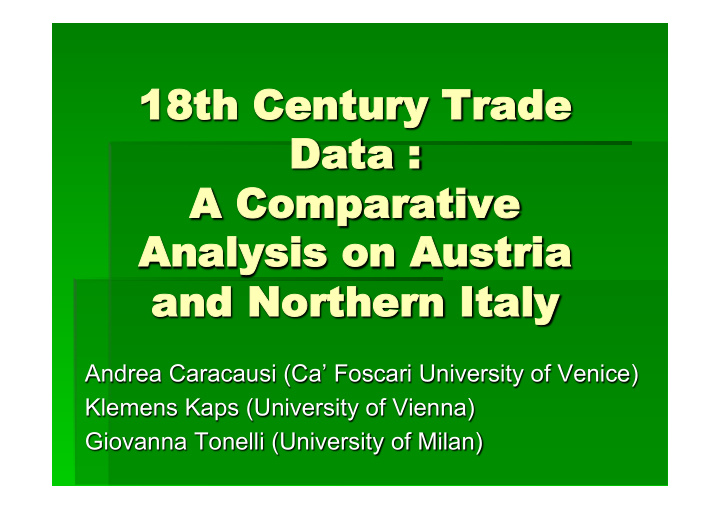



18t 18th h Cent entur ury Trade ade Dat ata a : : A Compar omparat ativ ive e Analy nalysis is on on Aus ustria ia and and Nor Norther hern n Italy aly Andrea Caracausi (Ca’ Foscari University of Venice) Klemens Kaps (University of Vienna) Giovanna Tonelli (University of Milan)
Part 1: Habsburg Empire Klemens Kaps (University of Vienna)
Phas hase e 1: 1: 1716-1746/ 1716-1746/49 49 Regional egional stat atis istics ics § Custom borders on the provincial level, registration of internal and external trade flows § Provincial trade offices, founded after 1716 in the Bohemian and Austrian lands à advisory boards for trade and commerce § Eventual compilation of provincial / regional trade statistics for Bohemia (1720, 1723, 1733-35) mixing money value and quantity § central customs commission, subordinated to the court chamber was founded (in 1714) to coordinate fixing the custom tolls, but it is unclear whether this included the collection of trade data
Phas hase e 2: 2: 1746/ 1746/49-1775 49-1775 Cent entraliz alizat ation ion and and mer mercant cantilis ilism § Administrative centralization after the loss of Silesia in the War of the Austrian succession gave an impulse for fostering both internal trade and proto-industrialization – trade statistic as bureaucratic tool for designing the corresponding policies, lowering of internal customs, augmentation of external trade barriers § Bureau of Trade was founded in 1746/49 coordinating the commercial councils in the provinces, which is considered the real start of a centrally organized trade statistic, which reached out to the Hungarian part as well § Until 1775 only provincial statistics have been preserved with the important exception of the external trade via Trieste (1763-65): only money value, Triestinian prices, in 1765: 55 commodity categories listed, trading partners available, fiscal year november 1st to october 31st § Exception: for Hungary exists a quite complete material covering the 1750s/60s
Phas hase e 3: 3: 1775-1789/ 1775-1789/92 92 Cus ustoms oms Union, Union, pr prot otect ectionis ionism m and and gr gradual adual cent centraliz alizat ation ion Customs union between the Bohemian and Austrian lands with the exception § of Tyrol, the Adriatic ports and newly acquired Galicia (incorporated into the union in 1784) § New central institutions – Customs Administration, Bank Charge Administration § One trade statistic for the territory of the customs union registering trade distinguishing between Galicia (until 1784), Tyrol, Hungary, Transylvania, foreign trade and foreign trade via Trieste. Milan and the Austrian Netherlands were kept outside of these statistics. § Viennese prices, only money value after 1778, price adaptation only when custom tolls are changed and only for those products : 1775, 1784, 1788 § Statistics for 1776-77 do not distinguish between internal and external trade; 1783-85: 265 commodity categories, 41 group categories, 21 main categories § 1784: incorporation of Galicia, but its statistic was preserved until 1792 (difference in prices, and much more commodity categories: up to 834)
Phas hase e 4: 4: 1789/ 1789/92-1827/ 92-1827/28: 28: One One cent central al stat atis istic, ic, but but many many problems pr oblems In 1789 one central trade statistic sets in (including the Hungarian part, but not Tyrol, the exempted territories, from 1792 this statistic was methodologically homogeneous (concerning prices and commodity categories) Spatial discontinuities remained: Western Galicia (1796-1809), Salzburg (from 1815), Tyrol (from 1825), Lombardy and Venetia (from 1826) Price changes by adaptation of new tariffs in 1803, 1810, further changes until 1828 are not known – export and import prices were adaptated seperately, import was registered far better than export because of the protectionist policy Trading partners are available form 1820 on, but reflect rather the borders crossed by the commodities than the real destination/origin Change of trade structure – exports of finished products increased (especially textiles like linen and wool, ironware), raw materials‘ imports increased as well
Recommend
More recommend